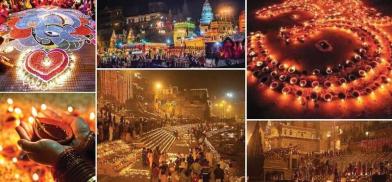Celebrating India's festival diversity: Festivals can enhance income, employment, mutual understanding
India annually celebrated major festival days of all faiths, but these festivities are largely confined to their believers. If those communities, however, were to become more open to secular participation on the principle that if faiths are for believers, associated festivities are for all to enjoy.

The recent Durga Puja festival, it has been claimed, generated a sum in excess of Rs 50,000 crores for the economy of West Bengal as well as employment for thousands of artisans and cultural workers. This was the beginning of the festive season in Bengal, which ends this week with Bhaiphota or Bhaidooj. There will be a hiatus until Christmas and on Basant Panchami in February Saraswati Puja will end this annual cycle of religious and cultural festivities.
Bengal traditionally has more than one festival a month. These are, however, marked mostly in individual homes. These must also be given a public character, albeit on a smaller scale, than Durga Puja, Sikh communities, for example, may be encouraged to undertake Akhand Paths, 'kirtans' and 'nagar parikramas', while publicising their community services on Guruparb.
Public aspects may be developed for the celebration of Navroz and Eids in the same way that Christmas in Bengal has become a secular celebration. Particular arts may be showcased in exhibitions and cultural performances, their cuisines made available for enjoyment, and their special attires modelled and sold while lectures may be held about the origins, history, practices and ethics of their faiths.
India annually celebrated major festival days of all faiths, but these festivities are largely confined to their believers. If those communities, however, were to become more open to secular participation on the principle that if faiths are for believers, associated festivities are for all to enjoy. With appropriate marketing, our festivals could generate far more gig employment, give our farmers, artisans and cultural workers more cash income, augment sales of attire, jewellery and other goods, educate our people in the beliefs and practices of all the communities that make up the culture and society of India. It will also increase domestic and international tourism, create goodwill in the Indo-Pacific, revive their interest in the historical connections between India and the world and possibly add a percentage or two to our GDP in the bargain.
India as a festival destination
India is a pilgrimage centre for all faiths in the world, including Christianity and Islam. The Judaic faith regards India kindly as the only nation where they never faced persecution and where one of the lost 12 tribes of Israel made their home. Zoroastrianism too found a home here. Jainism, Buddhism, and Sikhism originated here. Even far eastern belief systems have been influenced by us.
The Indian diaspora spread worldwide, carrying their beliefs and enriching their society with their practices. Hence India is best placed to capitalise on these resources through savvy marketing adequate infrastructure, connectivity and publicity. The development of infrastructure should be carried out by the corporate sector and local municipalities in all major pilgrim centres in cooperation with their faith leaders. Publicity campaigns through media and schools may educate all our people about the tenets of all faiths, to show respect for them and enjoy the associated celebrations.
Such dissemination of knowledge and inculcation of respect for all faiths will promote our mutual respect and harmony and enable communities to assist one another in improving their quality of life. Our manufacturing could be boosted, along with the transportation and hospitality sectors. Stronger connections could be made with South Asian and ASEAN societies, which could open up business and partnership opportunities. Our diplomatic relationships would develop a new dimension and our global leadership ambitions could be boosted.
Festivals will showcase culture
Entertainment is the second largest industry in the world after armaments, and such occasions could be the basis for international cultural festivals, generating more awareness and a better understanding of international art forms and even the extent to which they have been influenced by Indian arts or vice versa.
Our cultural workers who, outside the film and TV industries, live a precarious existence, particularly in rural India, would find occasions and platforms to practise and showcase their arts and earn a higher income as well as have the incentive to pass on their skills to future generations.
Festivities could also invite international delegations to participate and discuss developments in their faiths and communities, showcasing the social diversities within faiths and their adherents. The major celebratory event of faith such as Buddhism could rotate among various countries. Overall, the process will generate income, employment and an understanding that we have more in common and share a common stake in the welfare of our planet.
(The author is a retired Indian ambassador. Views are personal)









Post a Comment